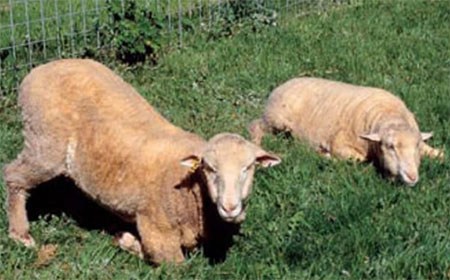Sheep producers are urged to be vigilant for the presence of footrot in their flocks at this time of the year. September to December is traditionally when ideal conditions exist for the spread and expression of this disease.This is the easiest time of the year to inspect and detect that footrot occurs in your flock.
Footrot exists as a spectrum of disease from very mild foot lesions causing inflammation only between the claws, to severe damage involving extensive lifting of the sole of the hoof and extreme damage to the claws.
There are three inter-related factors which will influence the spread and expression of the disease. These are:
The bacterium that causes Footrot Dichelobacter nodosus must be present.There are 10 strains of the bacteria ranging in virulence from mild to severe. Often there are a number of strains present in the one outbreak. The bacterium will remain within cracks in the hoofs and old lesions to reappear when conditions are ideal again.
The three main environmental factors required for the establishment and transmission of footrot are:
Footrot is more likely to present as a severe disease problem in areas with greater than 450 mm/year of average annual rainfall.In South Australia, high risk environmental areas for disease occurrence include the South East, Fleurieu Peninsula, Adelaide Hills, Kangaroo Island, parts of the mid-North and the lower part of the Eyre Peninsula. In most years, suitable conditions exist from September to November for the spread of the disease. In some years, where there has been an early autumn break, suitable conditions for expression and spread can exist in April and May.
The breed of sheep will also have some influence on the severity of footrot in a flock.Merinos are more susceptible than British breeds or cross bred sheep. Dorpers are very susceptible to footrot infection.
infection.
‘Its ok I only have foot scald or benign footrot lesions’
No it’s not.Foot scald is benign footrot and it is caused by D. nodosus.In a high rainfall environment, in a susceptible breed under ideal conditions, where no management such as foot-bathing or culling has occurred, then the bacteria may express to its full clinical potential and be visible in the flock. Disease severity may reflect organism virulence.However when animal, environment and management factors are not ideal benign lesions may contain virulent bacteria.
It is important to know what you are dealing with. Ignoring a footrot problem is costing you money and putting your neighbours at risk.The first step is to get an accurate diagnosis of what is causing lameness in your sheep. This should be undertaken by an experienced sheep veterinarian and/or department Animal Health Officer.They will be able to take samples so that an accurate laboratory diagnosis can be made. The laboratory results will help determine if more virulent strains of D. nodosus are present and what trading options are available. In many parts of South Australia this year, very dry conditions exist. In such situations, a laboratory analysis will provide a more accurate indication of the virulence of the infection than a clinical assessment.
Footrot can cause severe production loss, has welfare implications and is a notifiable disease in South Australia.As a notifiable disease movement restrictions are now enforced under the Livestock Act 1997, rather than issuing individual orders.The level of movement restriction will based on the virulence of the infection, including laboratory results. The trading options for owners will be formalised in a Property Disease Management Plan.
It is important to remember that the bacteria is not believed to survive for long periods in the paddock.Identifying carrier animals is an important part of disease management. With careful planning, and external help from competent animal health experts, footrot can usually be effectively managed within one or two seasons. However, to achieve this result, it is important to strictly adhere to the guidelines. Attention to detail is important. In undertaking a footrot management program the use of footrot contractors usually increases the chance of success.
To ignore lameness in your sheep is costing you money, and putting your neighbours at risk.Footrot is a not a life sentence, it is disease of sheep which, with planning and proper advice, can be cost effectively managed.
SheepConnect Tasmania has produced an excellent reference guide that provides photos of footrot and other common foot conditions available at https://sheepconnecttas.com.au/handy-guides/ . PIRSA Biosecurity also have fact sheets on footrot available at http://www.pir.sa.gov.au/biosecurity/animal_health/sheep/health/footrot .
If you have lame sheep and are unsure of what is causing it, or have any other questions, contact your local PIRSA Biosecurity Animal Health officer, veterinarian or livestock consultant.